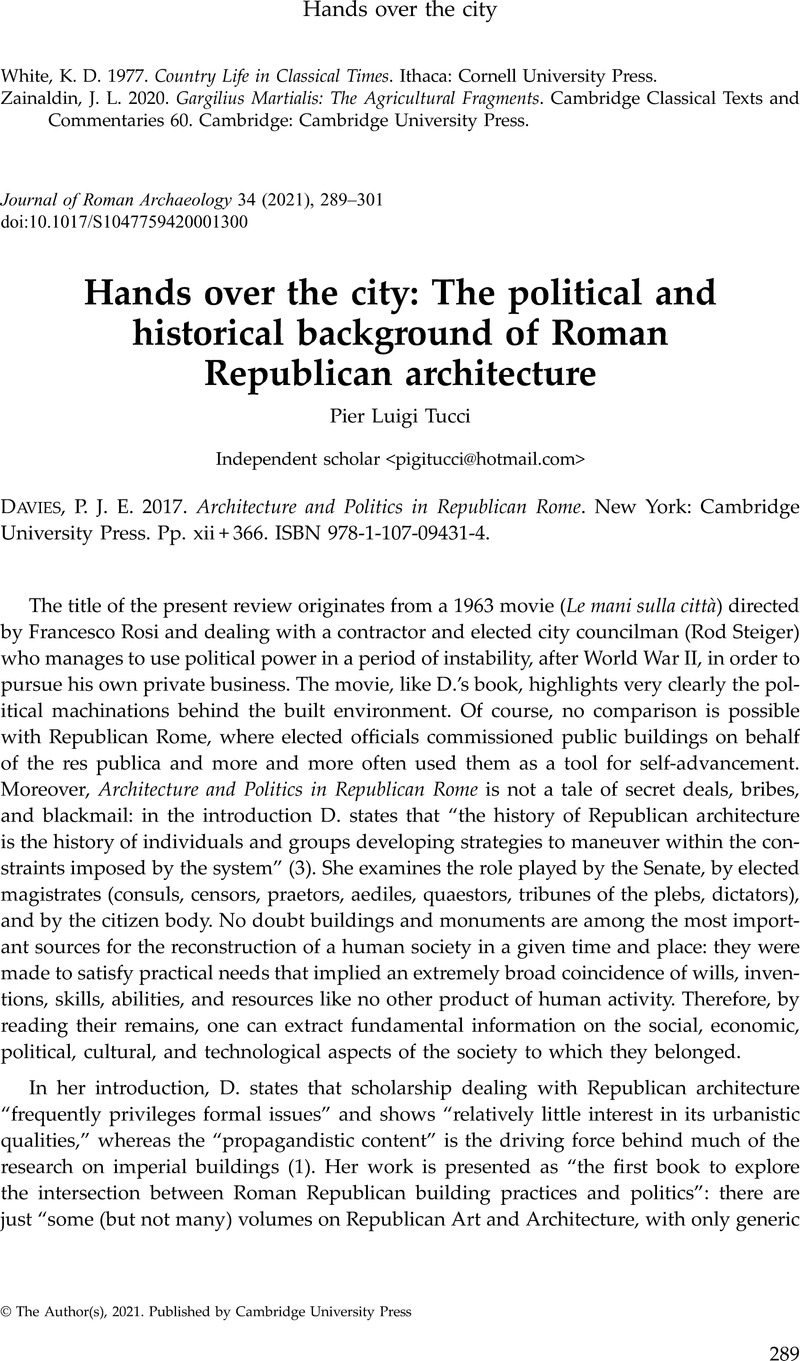No CrossRef data available.
Article contents
Hands over the city: The political and historical background of Roman Republican architecture - P. J. E. Davies 2017. Architecture and Politics in Republican Rome. New York: Cambridge University Press. Pp. xii + 366. ISBN 978-1-107-09431-4.
Published online by Cambridge University Press: 03 March 2021
Abstract
An abstract is not available for this content so a preview has been provided. Please use the Get access link above for information on how to access this content.

- Type
- Book Review
- Information
- Copyright
- Copyright © The Author(s), 2021. Published by Cambridge University Press
References
Bianchi, F. 2010. “Il tempio di Giove Statore e la scena del teatro di Marcello: maestranze e modelli decorativi tra epoca tardo repubblicana e media età imperial.” RendLinc 21: 285–322.Google Scholar
Cadario, M. 2011. “Teatro e propaganda, trionfo e mirabilia: considerazioni sul programma decorativo del teatro e della porticus di Pompeo.” Stratagemmi. Prospettive Teatrali 19: 11–68.Google Scholar
Caligari, P. 2001. Il mausoleo di Giulio Cesare nel Campo Marzio. Rome: Vetera Edizioni.Google Scholar
Castagnoli, F. 1985. “Per un aggiornamento della Forma Urbis del Lanciani.” In Roma. Archeologia nel Centro II, 313–19. Rome: De Luca.Google Scholar
Cifani, G. 2017. “Small, medium or extra-long? Prolegomena to any future metaphysics on the reconstruction of the Temple of Jupiter Optimus Maximus Capitolinus.” In The Age of Tarquinius Superbus. Central Italy in the Late 6th Century, ed. Lulof, P. S. and Smith, C. J., 113–22. Leuven: De Gruyter.Google Scholar
Coarelli, F. 1985. Il Foro Romano. Periodo repubblicano e augusteo. Rome: Edizioni Quasar.Google Scholar
Coarelli, F. 1988. Il Foro Boario. Dalle origini alla fine della Repubblica. Rome: Edizioni Quasar.Google Scholar
Coarelli, F. 1997. Il Campo Marzio. Dalle origini alla fine della Repubblica. Rome: Edizioni Quasar.Google Scholar
Coarelli, F. 2019a. “Hermodoros di Salamina.” In Salamis of Cyprus: History and Archaeology from the Earliest Times to Late Antiquity, ed. Rogge, S., Ioannou, C., and Mavrojannis, T., 545–67. Münster and New York: Waxmann.Google Scholar
Coarelli, F. 2019b. Statio. I luoghi dell'amministrazione nell'antica Roma. Rome: Edizioni Quasar.Google Scholar
Gros, P. 2010. “La nouvelle Rome de César: Réalité et utopie.” In Cesare: precursore o visionario?, ed. Urso, G., 265–84. Pisa: Edizioni ETS.Google Scholar
Gullini, G. 1991. “L'architettura e l'urbanistica.” In Princeps urbium. Cultura e vita sociale dell'Italia romana, ed. Pugliese Carratelli, G., 417–735. Milan: Libri Scheiwiller.Google Scholar
Kaderka, K. 2018. Les décors tympanaux des temples de Rome. Bordeaux: Ausonius Éditions.Google Scholar
Krautheimer, R. 1985. Rome of Alexander VII: 1655–1667. Princeton: Princeton University Press.Google Scholar
La Rocca, E. 1996. “Le tegole del tempio di Hera Lacinia ed il tempio della Fortuna Equestre: tra spoliazioni e restauri in età tardo-repubblicana.” In Il tesoro di Hera. Scoperte nel santuario di Hera Lacinia a Capo Colonna di Crotone, ed. Spadea, R., 89–105. Milan: Edizioni ET.Google Scholar
Liverani, P. 2008. “Cesare urbanista.” In Giulio Cesare. L'uomo, le imprese, il mito, ed. Gentili, G., 42–59. Milan: Silvana Editoriale.Google Scholar
Madeleine, S. 2015. Le théâtre de Pompée à Rome. Restitution de l'architecture et des systèmes mécaniques. Caen: Presses universitaires de Caen.Google Scholar
Marcattili, F. 2016–17. “Inversione della norma ed integrazione sociale: per un'interpretazione dei templi a cella trasversale.” RendPontAcc 89: 705–44.Google Scholar
Maschek, D. 2018. “Not census but deductio: Reconsidering the ‘Ara of Domitius Ahenobarbus.’” JRS 108: 27–52.Google Scholar
Monterroso Checa, A. 2010. Theatrum Pompei. Forma y arquitectura de la génesis del modelo teatral de Roma. Madrid: CSIC.Google Scholar
Senseney, J. R. 2011. “Adrift toward empire: The lost Porticus Octavia in Rome and the origins of the Imperial fora.” JSAH 70: 421–41.Google Scholar
Tomei, M. A., ed. 2010. Memories of Rome: The Aemilii and the Basilica at the Forum. Milan: Electa.Google Scholar
Tortorici, E. 1988. “Il tempio presso S. Salvatore in Campo: V. Vespignani ed Ermodoro di Salamina.” QuadTopAnt 10: 59–75.Google Scholar
Tucci, P. L. 2005. “‘Where high Moneta leads her steps sublime’: The ‘Tabularium’ and the Temple of Juno Moneta.” JRA 18, no. 1: 6–33.Google Scholar
Tucci, P. L. 2006. “Il tempio di Giove Capitolino e la sua influenza sui templi di età imperial.” JRA 19, no. 2: 386–92.Google Scholar
Tucci, P. L. 2013. “The Temple of Castor and Pollux in the Circus Flaminius: The state of the question.” PBSR 81: 91–127.Google Scholar
Tucci, P. L. 2013–14. “A new look at the Tabularium and the Capitoline Hill.” RendPontAcc 86: 3–83.Google Scholar
Tucci, P. L. 2018. The Temple of Peace in Rome. New York: Cambridge University Press.CrossRefGoogle Scholar
Tuori, K., and Nissin, L., eds. 2015. Public and Private in the Roman House and Society. JRA Suppl. 102. Portsmouth: Journal of Roman Archaeology, Supplementary Series.Google Scholar
von Hesberg, H., and Lipps, J.. 2010. “L'architecture romaine, évolution d'un champ d'études depuis les années 1950.” Perspective. Actualité en Histoire de l'Art 2: 215–39.Google Scholar
Wiseman, T. P. 1994. “Caesar, Pompey and Rome, 59–50 BC.” In The Cambridge Ancient History. Vol. 9, The Last Age of the Roman Republic, 146–43 BC, eds. Crook, J. A., Lintott, A., and Rawson, E., 368–423. Cambridge: Cambridge University Press.Google Scholar
Yegül, F., and Favro, D.. 2019. Roman Architecture and Urbanism: From the Origins to Late Antiquity. New York: Cambridge University Press.CrossRefGoogle Scholar


